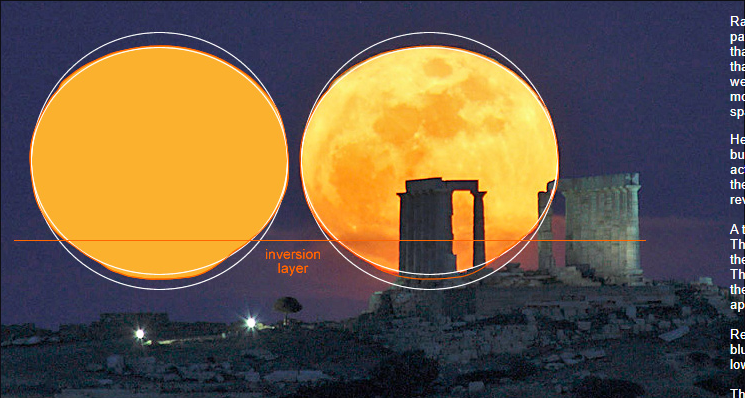Bulging Moon
Bulging Moon: Exploring the Phenomenon in Atmospheric Optics
Have you ever noticed that the rising or setting moon appears slightly flattened? Just like the sun, the moon experiences a flattening effect caused by the refraction of its rays through our atmosphere. However, under certain conditions, this phenomenon can take an intriguing twist, resulting in a bulging appearance at the lower limb of the moon. In this article, we will delve deeper into the fascinating topic of the "Bulging Moon" and explore the factors that contribute to this optical illusion.
Understanding Atmospheric Refraction
The curvature of our thin atmospheric shell plays a significant role in shaping the appearance of celestial objects. As the moon's rays pass through the Earth's atmosphere, they undergo refraction, which causes the rays to bend and follow a curved path. This refraction is responsible for making the moon's limb appear higher in the sky than its true position, creating a flattened appearance. The effect is more pronounced for rays originating from the lower limb of the moon.
The Role of Temperature Inversions
In certain atmospheric conditions, such as a temperature inversion, the lower layers of air can be warmer and less dense than usual. This variation in density leads to differential refraction, where the rays from the lower limb of the moon are refracted less strongly compared to those from the upper limb. Consequently, the lower limb appears bulged downwards, creating an intriguing visual effect.
Exploring the Bulging Phenomenon
When observing a bulging moon, it is interesting to note that the bulge itself represents an area of reduced flattening rather than an actual physical protrusion. By superimposing an ellipse and a circle on the flattened moon, we can visualize this reduction in flattening more clearly. The bulge occurs due to the differential refraction caused by the temperature inversion, adding a unique characteristic to the moon's appearance.
The Play of Colors
Another intriguing aspect of the bulging moon is the presence of colors around its rim. Red light is refracted less than green and blue, resulting in a reddish rim on the moon's lower limb and a hint of green on the top. This color variation adds to the visual allure of the phenomenon and enhances the overall experience of observing the bulging moon.
A Captivating Backdrop: The Temple of Poseidon
The stunning images of the bulging moon often feature a captivating backdrop - the Temple of Poseidon. This ancient Greek temple, built around 440 BC, stands proudly on a headland with the Aegean Sea surrounding it on three sides. Its graceful Doric columns provide a picturesque setting for capturing the bulging moon phenomenon.
Elias Chasiotis: The Photographer Behind the Lens
The images of the bulging moon showcased in this article were captured by Elias Chasiotis, a talented photographer with a keen interest in atmospheric optics. Elias managed to capture the enchanting sight of the Temple of Poseidon with the bulging moon in the background from a distance of 2 km. Using a Canon EOS 450D camera equipped with a Canon EF 70-200 F2.8 lens and a 2x converter, he achieved remarkable results with an exposure time of 0.4 seconds.
In conclusion, the "Bulging Moon" phenomenon offers a captivating insight into the wonders of atmospheric optics. Through the interplay of refraction and temperature inversions, the moon's appearance can take on a unique and visually striking form. Whether it's the flattened limb, the intriguing bulge, or the subtle colors, observing this phenomenon against the backdrop of ancient architecture like the Temple of Poseidon adds an extra layer of fascination. So, next time you gaze at the moon rising or setting, keep an eye out for its mysterious bulging shape and marvel at the captivating beauty of our atmosphere's optical effects.

Bulging Full Moon rising over the Temple of Poseidon, Cape Sounion, Greece. Imaged by Elias Chasiotis on April 28, 2010. ©Elias Chasiotis, shown with permission.

The rising and setting moon, like the sun, is usually slightly flattened.
Refraction by our curved thin shell of atmosphere rapidly thickening near the surface refracts the moons rays differentially.
Rays from the lower limb travel a curved path, concave towards earth’s centre, so that the limb appears higher in the sky than its true position. The effect is weaker for upper limb rays and thus the moon appears flattened. From a spacecraft the effect is extreme.
Here the flattened moon has an extra bulge at the lower limb. The bulge is actually an area of reduced flattening as the superimposed ellipse and circle reveal.
A temperature inversion is the cause. The lower air layers are warmer and therefore slightly less dense than usual. The less dense air refracts the rays from the lower limb less strongly causing it to appear bulged downwards.
Red light is refracted less than green and blue producing a red rim on the moon's lower rim and a hint of green on the top.
The Temple of Poseidon with its graceful Doric columns was built in c440 BC on the site of a much earlier one. It stands on a headland with the Aegean on three of its sides.
Elias imaged the temple from 2 km away. Canon EOS 450D, Canon EF 70-200 F2.8, 2x converter at F7.1, ISO 200, exposure 0.4 sec.
Note: this article has been automatically converted from the old site and may not appear as intended. You can find the original article here.
Reference Atmospheric Optics
If you use any of the definitions, information, or data presented on Atmospheric Optics, please copy the link or reference below to properly credit us as the reference source. Thank you!
-
<a href="https://atoptics.co.uk/blog/bulging-moon/">Bulging Moon</a>
-
"Bulging Moon". Atmospheric Optics. Accessed on November 26, 2024. https://atoptics.co.uk/blog/bulging-moon/.
-
"Bulging Moon". Atmospheric Optics, https://atoptics.co.uk/blog/bulging-moon/. Accessed 26 November, 2024
-
Bulging Moon. Atmospheric Optics. Retrieved from https://atoptics.co.uk/blog/bulging-moon/.